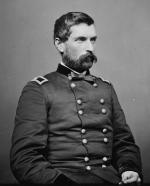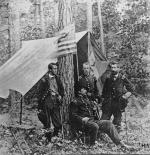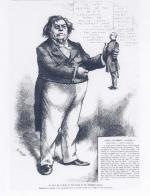![header=[Marker Text] body=[Outstanding Civil War general and hero of the Battle of Gettysburg, was born here Feb. 14, 1824. After 1828 he lived in Norristown, where he is buried.] sign](http://explorepahistory.com/kora/files/1/10/1-A-1E7-139-ExplorePAHistory-a0h2l3-a_450.jpg)
Mouse over for marker text
Name:
Winfield S. Hancock
Region:
Laurel Highlands/Southern Alleghenies
County:
Montgomery
Marker Location:
PA 309 south of Montgomeryville
Dedication Date:
September 11, 1947
Behind the Marker
In this house, twin brothers Winfield and Hilary Hancock were born in 1824. Their father, a prominent Democrat and lawyer, supported Winfield's desire to join the army and sent him to West Point, where he graduated in the class of 1844.
After brief service at the end of the Mexican War, Lieutenant Hancock was posted to St. Louis, where he married. As part of the 6th United States Infantry, Hancock went to Florida to fight Seminoles, then to Kansas and Utah. When war erupted in 1861, Captain Hancock was regimental quartermaster for his regiment, then stationed in California. Some of his closest friends were Southern-born, and Hancock was saddened when they left to join the Confederacy.
Promoted to brigadier general of volunteers, Hancock was assigned to a brigade in what became the Sixth Corps, Army of the Potomac. Watching Hancock's gallant performance during the Battle of Williamsburg (May 5, 1862), General George B. McClellan described it as "superb." The nickname stuck and thereafter he was Hancock the Superb.
After fighting in the Seven Days' Battles, Hancock's brigade next fought at Antietam. During the latter stages of this bloody battle, when the commander of the First Division of the Second Corps was mortally wounded, McClellan placed Hancock in command of the division.
Soon promoted to major general, he led his division against the stonewall at Marye's Heights at Fredericksburg, suffering heavy casualties. At Chancellorsville in May, Hancock's troops fought bravely and suffered heavy casualties around the Chancellor House until withdrawn to the main line as General Joseph Hooker withdrew the army.
Thus, by June of 1863, Hancock had earned a reputation as a fighting general that his troops adored. His hands always covered in clean white gloves, Hancock also had a reputation as a vociferous curser, who could out-swear other generals. When his corps commander, General Darius N. Couch, received a transfer to assume command of the defense of Pennsylvania, Hancock became commander of the Second Corps.
Some 13,000 strong, the Second Corps included some of the army's best-known units, including the 5th New Hampshire, the Irish Brigade, Philadelphia Brigade, and a tough unit of Midwesterners nicknamed the Gibraltar Brigade. Two of the corps' three division commanders were Pennsylvanians-John Gibbon and Alexander Hays.
After George G. Meade was promoted to command of the Army of the Potomac, he relied on his friend Hancock in a very big way. When Meade received word of
George G. Meade was promoted to command of the Army of the Potomac, he relied on his friend Hancock in a very big way. When Meade received word of  General John F. Reynolds' death at Gettysburg, he rode from his headquarters at Taneytown, Maryland to the nearby camp of the Second Corps and told Hancock to go to the battlefield, take charge, and assess the situation. Meade had planned a defensive battle in Maryland, but, he informed Hancock, if the situation at Gettysburg looked favorable, he would concentrate the army and fight General Lee there.
General John F. Reynolds' death at Gettysburg, he rode from his headquarters at Taneytown, Maryland to the nearby camp of the Second Corps and told Hancock to go to the battlefield, take charge, and assess the situation. Meade had planned a defensive battle in Maryland, but, he informed Hancock, if the situation at Gettysburg looked favorable, he would concentrate the army and fight General Lee there.
Hancock arrived on Cemetery Hill as defeated and demoralized Yankee soldiers were reforming. Quickly taking charge, his commanding presence and reassurance helped immeasurably to bring order out of chaos. Hancock's late afternoon messages from the field, cemented Meade's decision to bring the army to Gettysburg.
On July 2, Meade placed Hancock in charge of the left end of the battlefield, after General Daniel E. Sickles was wounded and reinforcements were needed to repair the damage Sickles caused by his unauthorized advance. On July 3, Hancock's veterans repelled Pickett's Charge, during which the general was wounded. Hancock recuperated and returned to command in the spring of 1864, but his Gettysburg wound caused problems and eventually forced him to leave active duty. The general remained in the army after the war.
In 1880, he was the Democratic nominee for president, but lost the election to James A. Garfield by a mere 7,000 votes. Hancock died in 1886 and is buried in Montgomery Cemetery in Norristown.
After brief service at the end of the Mexican War, Lieutenant Hancock was posted to St. Louis, where he married. As part of the 6th United States Infantry, Hancock went to Florida to fight Seminoles, then to Kansas and Utah. When war erupted in 1861, Captain Hancock was regimental quartermaster for his regiment, then stationed in California. Some of his closest friends were Southern-born, and Hancock was saddened when they left to join the Confederacy.
Promoted to brigadier general of volunteers, Hancock was assigned to a brigade in what became the Sixth Corps, Army of the Potomac. Watching Hancock's gallant performance during the Battle of Williamsburg (May 5, 1862), General George B. McClellan described it as "superb." The nickname stuck and thereafter he was Hancock the Superb.
After fighting in the Seven Days' Battles, Hancock's brigade next fought at Antietam. During the latter stages of this bloody battle, when the commander of the First Division of the Second Corps was mortally wounded, McClellan placed Hancock in command of the division.
Soon promoted to major general, he led his division against the stonewall at Marye's Heights at Fredericksburg, suffering heavy casualties. At Chancellorsville in May, Hancock's troops fought bravely and suffered heavy casualties around the Chancellor House until withdrawn to the main line as General Joseph Hooker withdrew the army.
Thus, by June of 1863, Hancock had earned a reputation as a fighting general that his troops adored. His hands always covered in clean white gloves, Hancock also had a reputation as a vociferous curser, who could out-swear other generals. When his corps commander, General Darius N. Couch, received a transfer to assume command of the defense of Pennsylvania, Hancock became commander of the Second Corps.
Some 13,000 strong, the Second Corps included some of the army's best-known units, including the 5th New Hampshire, the Irish Brigade, Philadelphia Brigade, and a tough unit of Midwesterners nicknamed the Gibraltar Brigade. Two of the corps' three division commanders were Pennsylvanians-John Gibbon and Alexander Hays.
After
Hancock arrived on Cemetery Hill as defeated and demoralized Yankee soldiers were reforming. Quickly taking charge, his commanding presence and reassurance helped immeasurably to bring order out of chaos. Hancock's late afternoon messages from the field, cemented Meade's decision to bring the army to Gettysburg.
On July 2, Meade placed Hancock in charge of the left end of the battlefield, after General Daniel E. Sickles was wounded and reinforcements were needed to repair the damage Sickles caused by his unauthorized advance. On July 3, Hancock's veterans repelled Pickett's Charge, during which the general was wounded. Hancock recuperated and returned to command in the spring of 1864, but his Gettysburg wound caused problems and eventually forced him to leave active duty. The general remained in the army after the war.
In 1880, he was the Democratic nominee for president, but lost the election to James A. Garfield by a mere 7,000 votes. Hancock died in 1886 and is buried in Montgomery Cemetery in Norristown.









